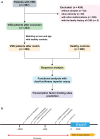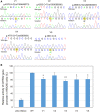Genetic analysis of the CITED2 gene promoter in isolated and sporadic congenital ventricular septal defects
- PMID: 33439552
- PMCID: PMC7882930
- DOI: 10.1111/jcmm.16218
Genetic analysis of the CITED2 gene promoter in isolated and sporadic congenital ventricular septal defects
Abstract
Ventricular septal defect (VSD) is the most common congenital heart defect. Previous studies have reported genetic variations in the encoding region of CITED2 highly associated with cardiac malformation but the role of CITED2 gene promoter variations in VSD patients has not yet been explored. We investigated the variation of CITED2 gene promoter and its impacts on gene promoter activity in the DNA of paediatric VSD patients. A total of seven variations were identified by Sanger sequencing in the CITED2 gene promoter region in 400 subjects, including 200 isolated and sporadic VSD patients and 200 healthy controls. Using dual-luciferase reporter assay, we found four of the 7 variations identified significantly decreased the transcriptional activity of the CITED2 gene promoter in HEK-293 cells (P < .05). Further, a bioinformatic analysis with the JASPAR databases was performed and a cluster of putative binding sites for transcription factors was created or disrupted by these variations, leading to low expression of CITED2 protein and development of VSD. Our study for the first time demonstrates genetic variations in the CITED2 gene promoter in the Han Chinese population and the role of these variations in the development of VSD, providing new insights into the aetiology of CHD.
Keywords: congenital heart disease; gene; genetic; ventricular septal defect.
© 2021 The Authors. Journal of Cellular and Molecular Medicine published by Foundation for Cellular and Molecular Medicine and John Wiley & Sons Ltd.
Conflict of interest statement
The authors declare no conflict of interest with respect to the authorship and publication of this article.
Figures



Similar articles
-
Molecular and cellular role of variants of the promoter region of HAND1 gene in sporadic and isolated ventricular septal defect.Mol Cell Biochem. 2025 Mar;480(3):1657-1667. doi: 10.1007/s11010-024-05088-9. Epub 2024 Aug 6. Mol Cell Biochem. 2025. PMID: 39107573
-
Identification of variants of ISL1 gene promoter and cellular functions in isolated ventricular septal defects.Am J Physiol Cell Physiol. 2021 Sep 1;321(3):C443-C452. doi: 10.1152/ajpcell.00167.2021. Epub 2021 Jul 14. Am J Physiol Cell Physiol. 2021. PMID: 34260301
-
Sequence variations in GATA4 and CITED2 gene among patients with cardiac septation defects from Xinjiang, China.Cardiol Young. 2024 Jul;34(7):1506-1513. doi: 10.1017/S1047951124000192. Epub 2024 Mar 8. Cardiol Young. 2024. PMID: 38456293
-
High-risk genes involved in common septal defects of congenital heart disease.Gene. 2022 Oct 5;840:146745. doi: 10.1016/j.gene.2022.146745. Epub 2022 Jul 18. Gene. 2022. PMID: 35863714
-
What have we learned from 691 prenatal chromosomal microarrays for ventricular septal defects?Acta Obstet Gynecol Scand. 2020 Jun;99(6):757-764. doi: 10.1111/aogs.13708. Epub 2019 Sep 9. Acta Obstet Gynecol Scand. 2020. PMID: 31424084
Cited by
-
Identification and Functional Verification of CITED2 Gene Promoter Region in Patients with Patent Ductus Arteriosus.Int J Mol Sci. 2023 Nov 11;24(22):16204. doi: 10.3390/ijms242216204. Int J Mol Sci. 2023. PMID: 38003393 Free PMC article.
-
Identification of SOX18 as a New Gene Predisposing to Congenital Heart Disease.Diagnostics (Basel). 2022 Aug 8;12(8):1917. doi: 10.3390/diagnostics12081917. Diagnostics (Basel). 2022. PMID: 36010266 Free PMC article.
-
MYRF: A New Regulator of Cardiac and Early Gonadal Development-Insights from Single Cell RNA Sequencing Analysis.J Clin Med. 2022 Aug 18;11(16):4858. doi: 10.3390/jcm11164858. J Clin Med. 2022. PMID: 36013096 Free PMC article.
-
NOTCH2, ATIC, MRI1, SLC6A13, ATP13A2 Genetic Variations are Associated with Ventricular Septal Defect in the Chinese Tibetan Population Through Whole-Exome Sequencing.Pharmgenomics Pers Med. 2023 Apr 27;16:389-400. doi: 10.2147/PGPM.S404438. eCollection 2023. Pharmgenomics Pers Med. 2023. PMID: 37138656 Free PMC article.
-
Molecular and cellular role of variants of the promoter region of HAND1 gene in sporadic and isolated ventricular septal defect.Mol Cell Biochem. 2025 Mar;480(3):1657-1667. doi: 10.1007/s11010-024-05088-9. Epub 2024 Aug 6. Mol Cell Biochem. 2025. PMID: 39107573
References
Publication types
MeSH terms
Substances
Grants and funding
- 81870288/Natural Science Foundation of China
- 2019XK310001/the Non-profit Central Research Institute Fund of Chinese Academy of Medical Sciences
- 2018TX31002/the Non-profit Central Research Institute Fund of Chinese Academy of Medical Sciences
- 2019BWKY010/Tianjin Binhai New Area Health Comission
- 18PTZWHZ00060/Tianjin Science and Technology Project
LinkOut - more resources
Full Text Sources
Other Literature Sources
Miscellaneous

